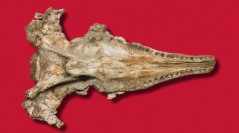

 Geodiversitas
45 (22) - Pages 659-679
Geodiversitas
45 (22) - Pages 659-679Contrasting with their suction feeding modern relatives in the families Kogiidae and Physeteridae, Miocene physeteroids display a broad range of feeding strategies. Despite the continuous improvements of the fossil record, the transition from the earliest sperm whales to suction feeding forms as well as the once prominent macroraptorial forms remains poorly understood. In the present work, we investigate a partial sperm whale skull from Lower Miocene (Burdigalian) strata of the Chilcatay Formation of the East Pisco Basin, along the southern coast of Peru. Based on this specimen, we describe a new species in the genus Diaphorocetus Ameghino, 1894, which was previously known only by the holotype of Diaphorocetus poucheti (Moreno, 1892) from a roughly synchronous unit in Patagonia (Argentina). Differing from the latter in its smaller cranial dimensions, higher tooth count, and minor differences in the position of facial foramina, the new species Diaphorocetus ortegai n. sp. confirms a key character of D. poucheti, the marked dorsoventral flattening of the maxillary portion of the rostrum. Such cranial proportions suggest that, compared to other physeteroids, D. poucheti and D. ortegai n. sp. were more efficient at performing fast lateral sweeps of their rostra to capture small- to medium-sized prey items with their proportionally small teeth. Recovered as stem physeteroids in our phylogenetic analysis, these sister species contribute to the ecomorphological disparity of sperm whales during the Early Miocene, but without displaying any of the cranial and dental changes occurring in later, macroraptorial and suction feeding sperm whales. The description of a new species of Diaphorocetus from southern Peru increases the similarities between the toothed whale faunas from the local Chilcatay Formation and the Gaiman and Monte Leon formations of Argentinian Patagonia, pointing not only to dispersal routes between the southeastern Pacific and southwestern Atlantic during the Burdigalian, but also to relatively similar ecological settings along the coasts of Peru and Patagonia at that time.
Physeteroidea, Burdigalian, Chilcatay Formation, Diaphorocetus, feeding, dispersal, Argentina, new species